Page 2 of 4
Re: Materials, Tools, and Techniques for Outdoor Track
Posted: Fri 14. Nov 2014 16:52
by Joel, LeNoir
I like the brick underlying idea. Nice empty space to work with. Keep the pictures coming.
Re: Materials, Tools, and Techniques for Outdoor Track
Posted: Mon 17. Nov 2014 00:18
by Ned
Thanks to everyone for their feedback.
Perhaps the best materials for making a track permanently located on the ground outside would be 1/8” x 4' x 8' fiberglass sheets suggested by Mike with type 430 stainless steel music wire suggested by Joel. Although this type of stainless steel is magnetic, I suspect that the diameter of the stainless wire would have to be larger to provide the same attractive force as common music wire. The stainless music wire could be glued on top of the fiberglass sheet and the track surface between the wires could be filled with Bondo Body Filler as suggested by Mike.
An alternative I'm considering is a combination of the fiberglass sheets (which, at Home Depot, are only .090” thick) and the .032” standard music wire I'm currently using. Except for the cut ends, this wire resists rusting in plain tap water. I would cut the fiberglass sheets to size as needed and reinforce them with cleats of the same material glued to the backside. Then I'd cut grooves/slots in each section about .034” deep, press fit the wire into the grooves, coat the wire with Bondo Fiberglass Resin, and scrape off the excess Bondo. I suspect that the Bondo resin would act as an adhesive to hold the wire in the groove as well as provide a waterproof seal over the wire. If need be, I'd apply another coat of Bondo resin or epoxy paint to assure a waterproof seal over the wire. If the fiberglass sheets were .125” thick instead of .090”, I think this system would work. Might not work if only .090” thick. What do you think?
Here are some more photos of how I'm making the road course. I do the work on a 4' x 8' table made special for this project. The table is located outside under a large grape arbor near the permanent location of the course.
The first 2 photos illustrate Step 1, gluing pieces of insulation board together to make a section of track.
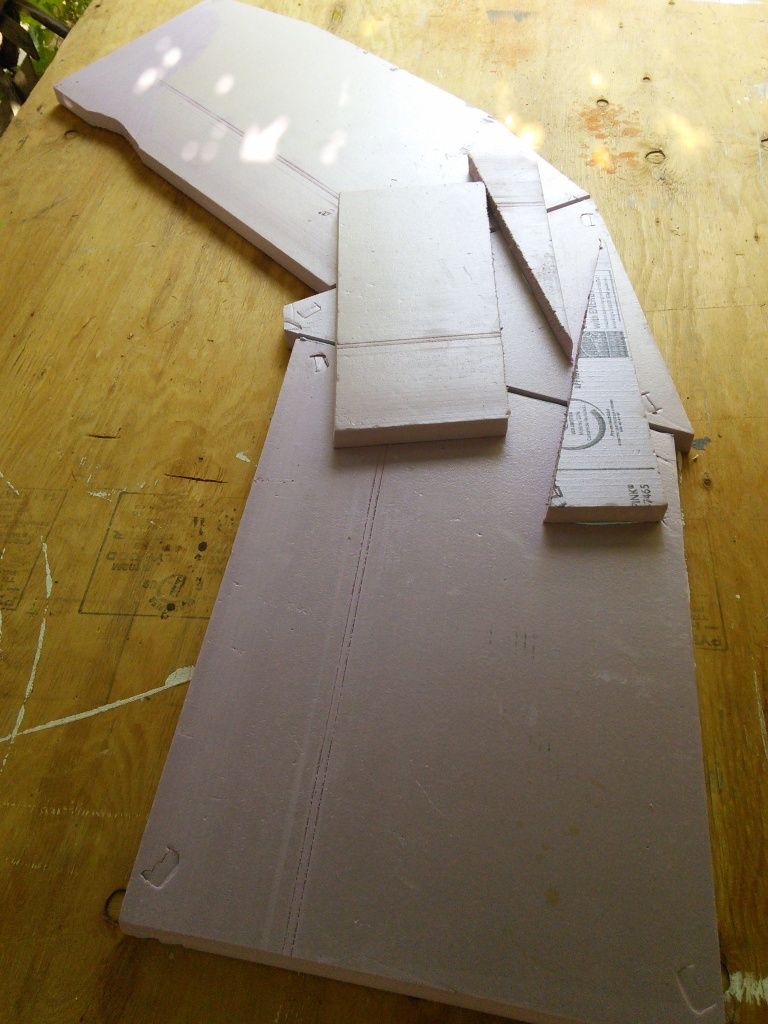
[/URL]
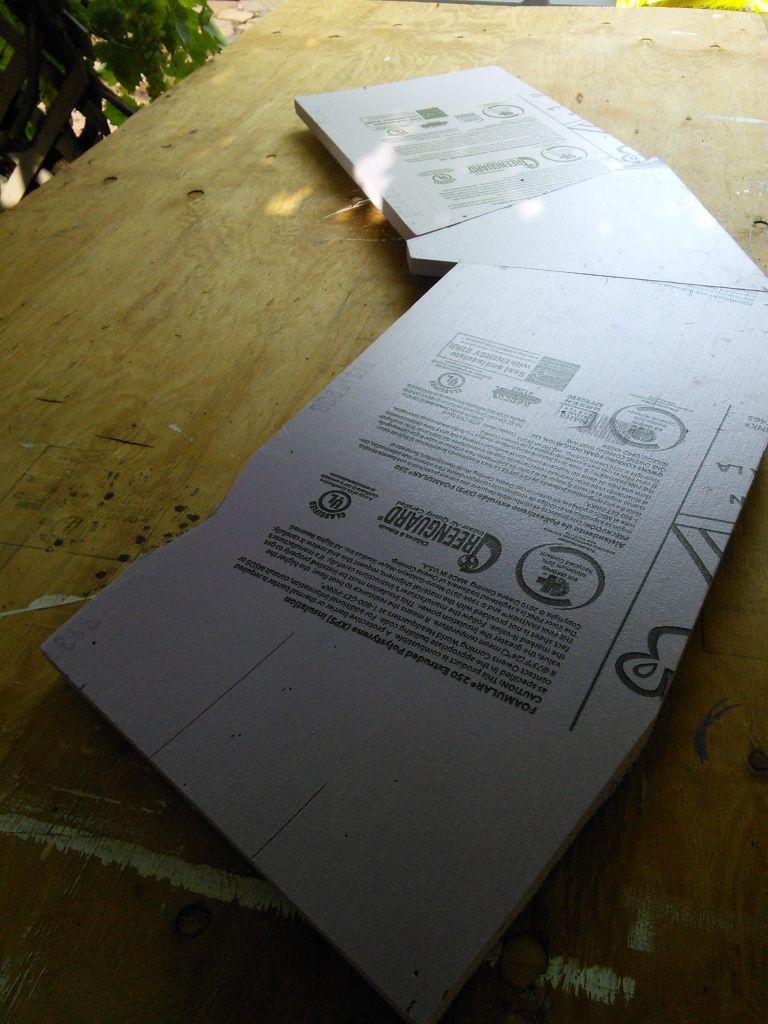
[/URL]
This next picture shows some of the tools and techniques I used. It also illustrates Step 4. After taking this picture I started to apply one coat of elastomeric roof coating to the insulation board before cutting the slot. The flexible Lexan strip, available from oldslotracer.com, is very helpful in drawing curves and routing slots.
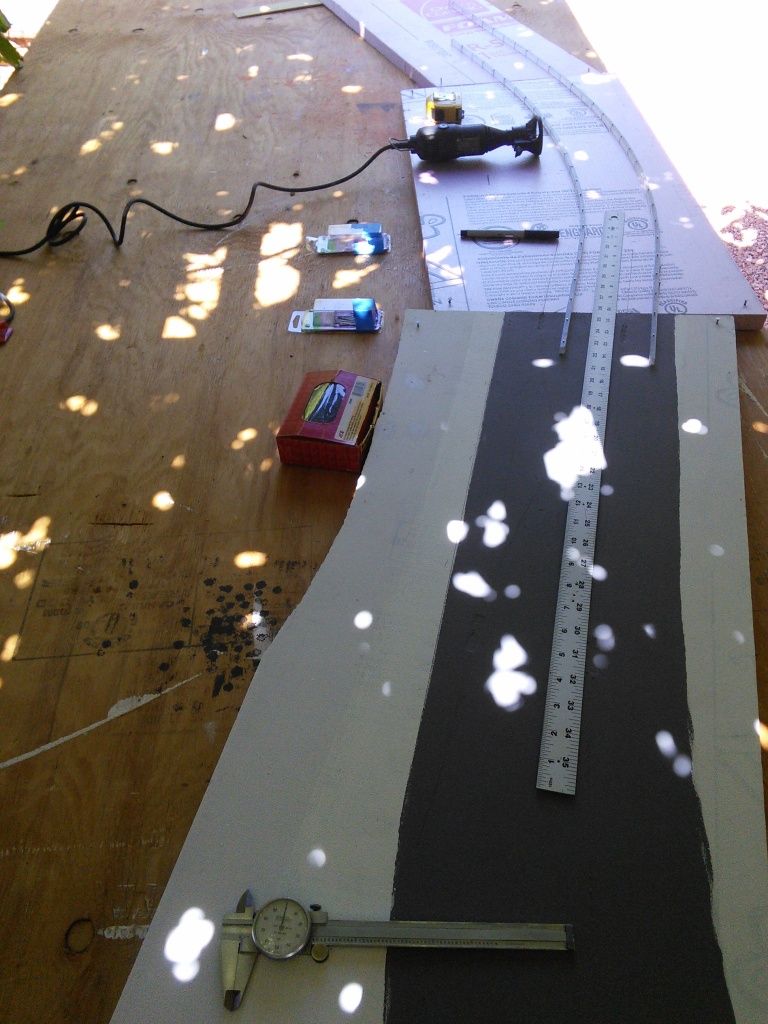
[/URL]
The next 2 pictures illustrates Step 5, cutting a slot in the insulation board using a Dremel tool with a router attachment guided by the Lexan strip.
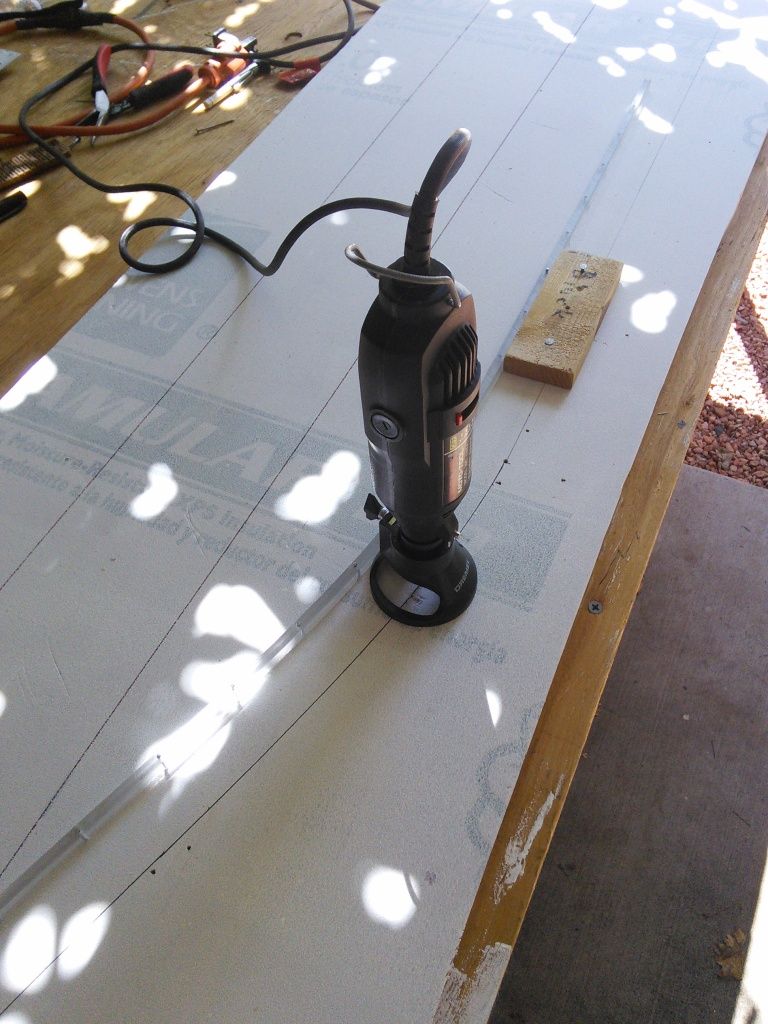
[/URL]
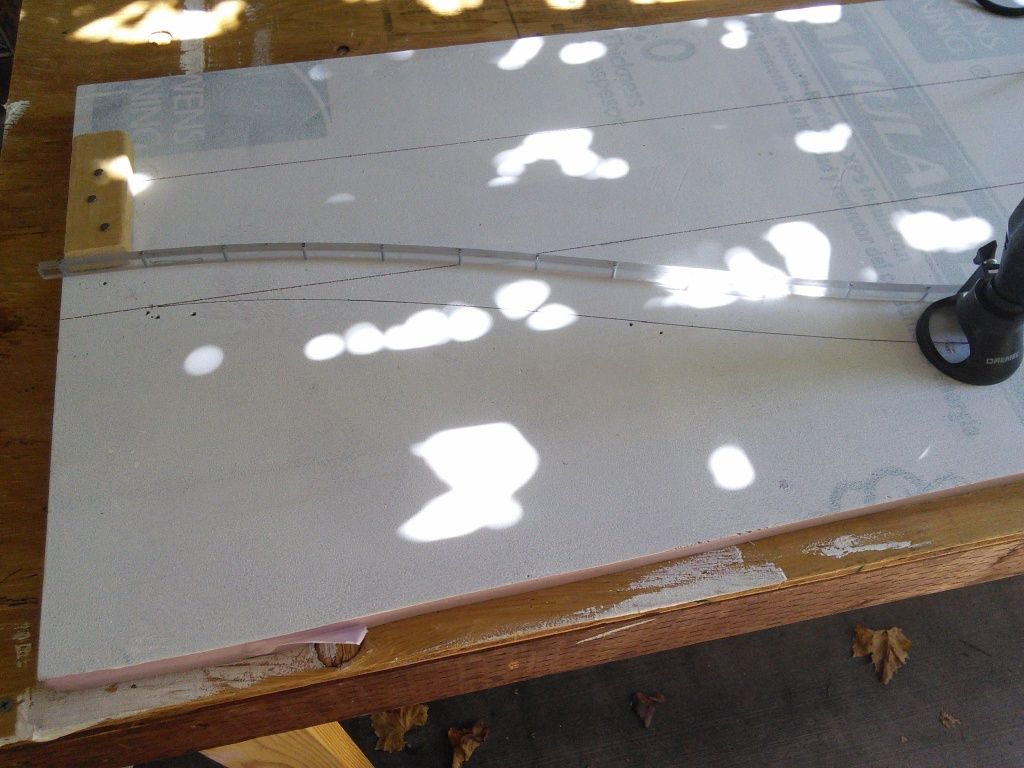
[/URL]
I plan to post more photos in the future.
Many thanks to Keld for providing this forum.
Re: Materials, Tools, and Techniques for Outdoor Track
Posted: Wed 19. Nov 2014 03:51
by Ned
Here are a few more pictures.
The first one shows a section of track where I made a cut in the board so I could change the banking from right to left. To make the banking more pronounced, I sanded away some of the board where the tires ride on the inside of the curve. That is shown by the band of white paint in the middle of the gray road. This section of track has only one wire (not two) running down the middle of the gray road.
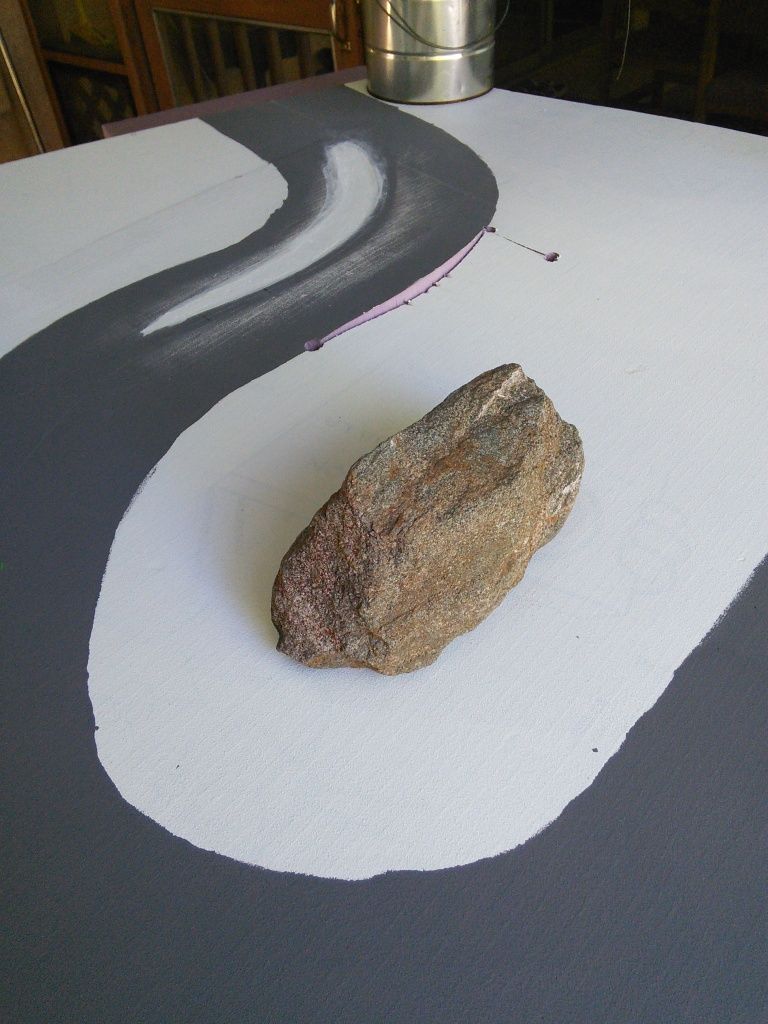
[/URL]
This next picture shows 10 sections of track almost ready to be permanently installed on the foundation. The white rectangles indicate where the lane change plates are located.
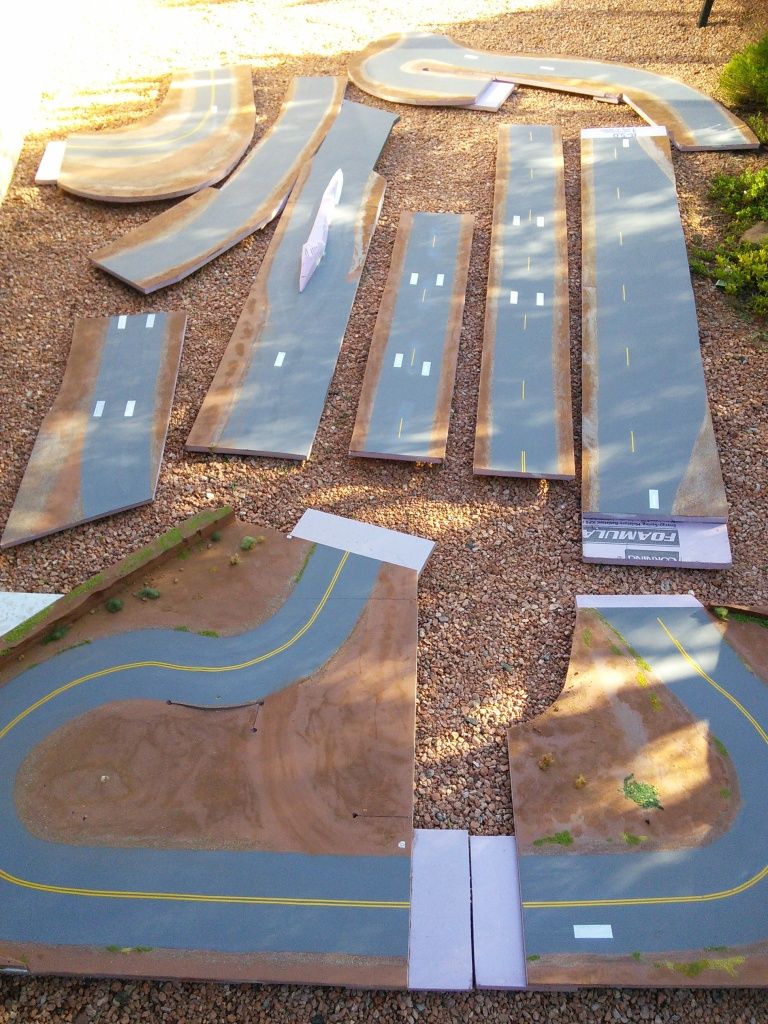
[/URL]
This picture illustrates how sections of track were glued together on the ground. Weight was placed on top of the glued joints while the glue dried.
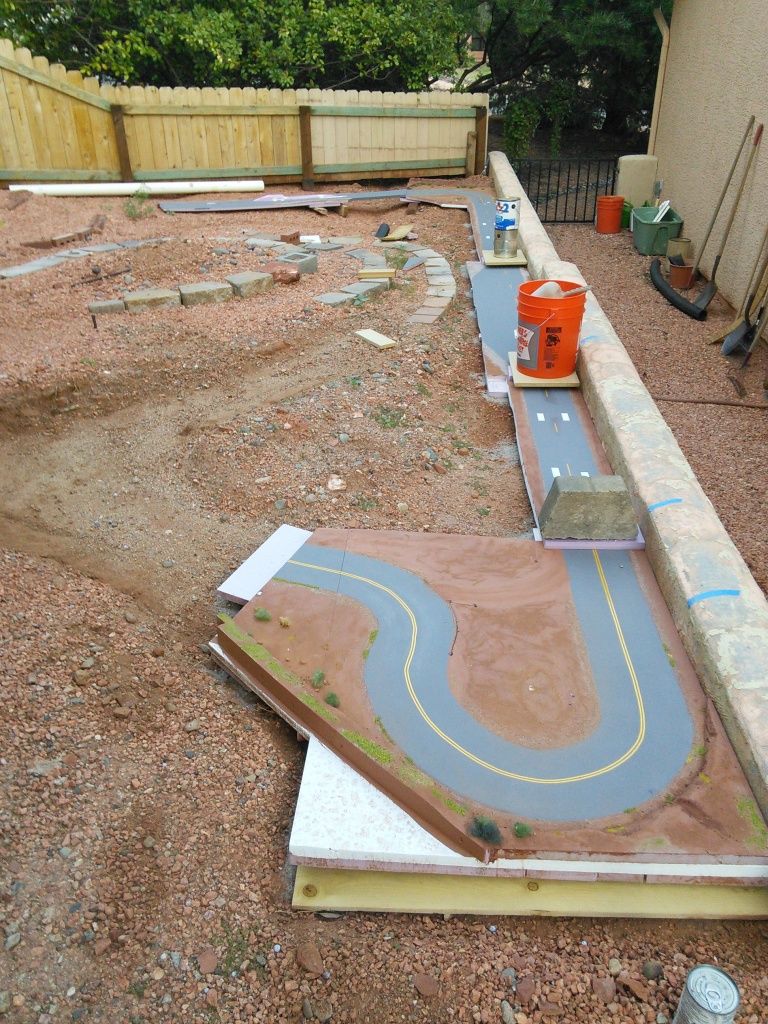
[/URL]
I used 1/8" wide yellow automotive pin-striping tape to stripe the highway. Let me know if you have any questions or suggestions.
Ned
Re: Materials, Tools, and Techniques for Outdoor Track
Posted: Thu 20. Nov 2014 04:48
by vmibert
Wow! Your track looks incredible! You may be on to something - as there is already a big following of model railroad hobbyists who have built outdoor model railroads.
My project stalled a little - I have to repair my band saw and I ended up in the hospital for a severe case of Vertigo. I'm planning on continuing my track project, this weekend.
Sincerely,
Bert
Re: Materials, Tools, and Techniques for Outdoor Track
Posted: Thu 20. Nov 2014 18:41
by goatdope
Great looking track Ned. Very interested in how the cars run on that surface. I suspect the running will be almost silent as opposed to plywood or some other hard surface.
Re: Materials, Tools, and Techniques for Outdoor Track
Posted: Thu 20. Nov 2014 20:24
by Ned
Thanks for the compliment Bert. Hope you're feeling better. When you're up this way, stop in and see us.
Ken, the track surface has a light texture. There are 3 coats of elastomeric white roof coating and one coat of flat acrylic gray exterior house paint. All were applied with a foam roller and all of these coatings are quite flexible. The track surface is not the least bit sticky. It cleans easily. The cars perform well on the surface even with a little bit of dust and dirt. The surface is probably harder than you think. The cars definitely make noise when running but probably a little less than on MDF or plywood. Also, I suspect that the noise is a lower frequency.
Here are a few more pictures.
The first one is taken from the southwest corner of the layout. My unpainted white car is in the pit lane. While under construction I have used various kinds of weights to force the foam to bend and to keep the track from blowing away.
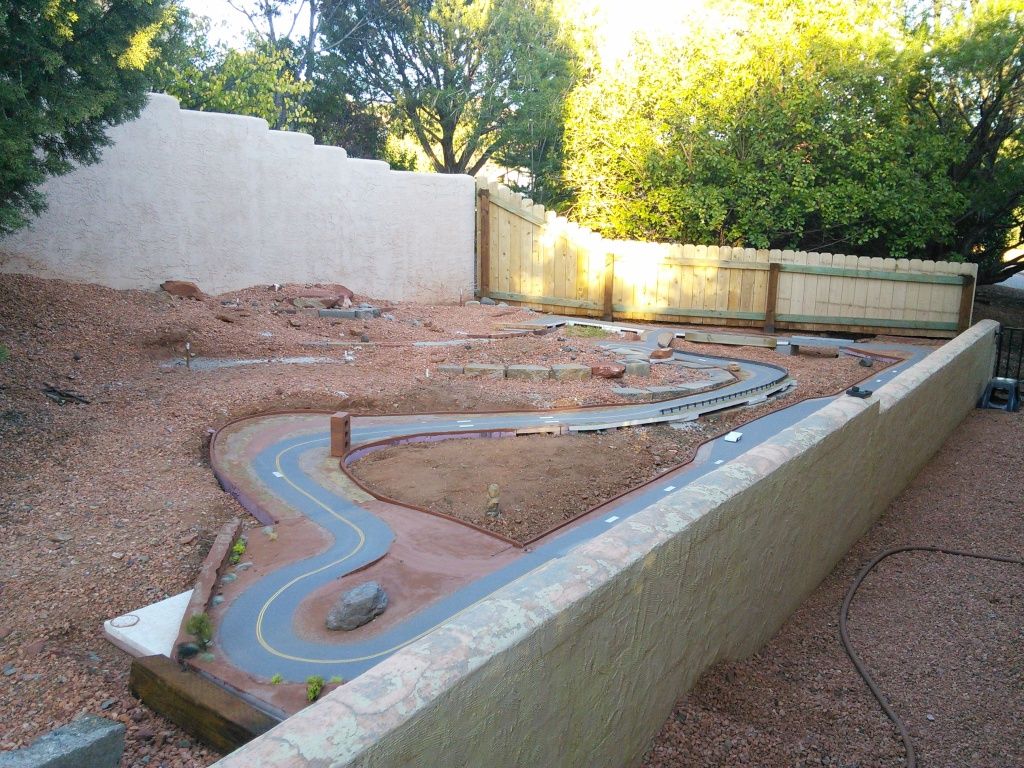
[/URL]
Here is one taken from the southeast corner. In the right-center of the picture you can see the one lane shortcut I added to complete a shorter circuit. The remainder of the road, which I expect to complete in the spring, will be very windy and more difficult to make.
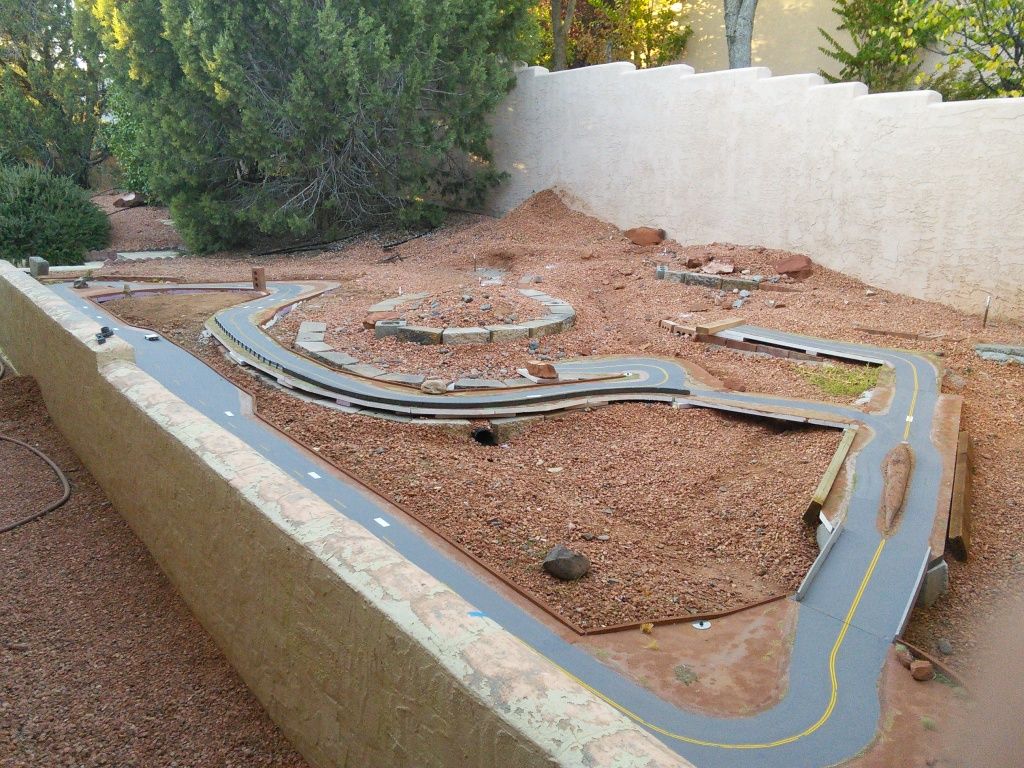
[/URL]
This next picture is a closeup of a banked hairpin turn. The stone wall in the foreground is made from 1/2” thick pink foam insulation board.
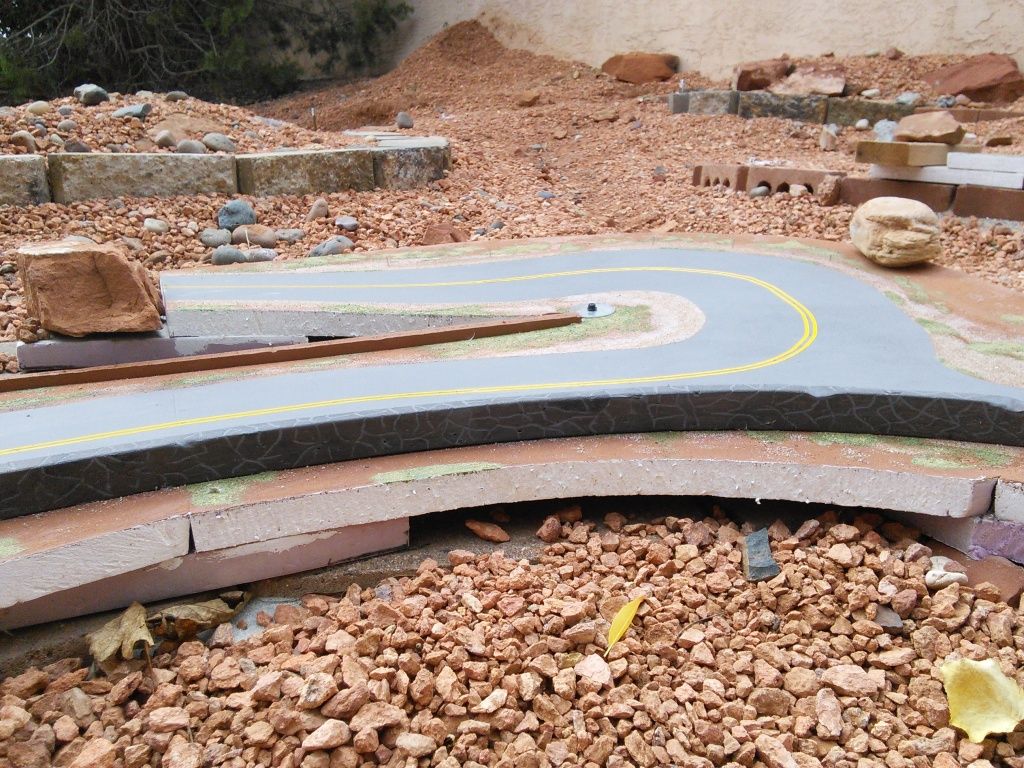
[/URL]
Another picture taken from the southwest corner looking northeast. Note the off-road shortcut near the gray rock in the foreground and the run-off in the dirt by the traffic cones northeast of the gray rock. One great thing about MagRacing is that the technology allows you to make any circuit configuration that you want. I'm building my road so I can run clockwise as well as counter clockwise. On race day hopefully all cars will be running in the same direction!

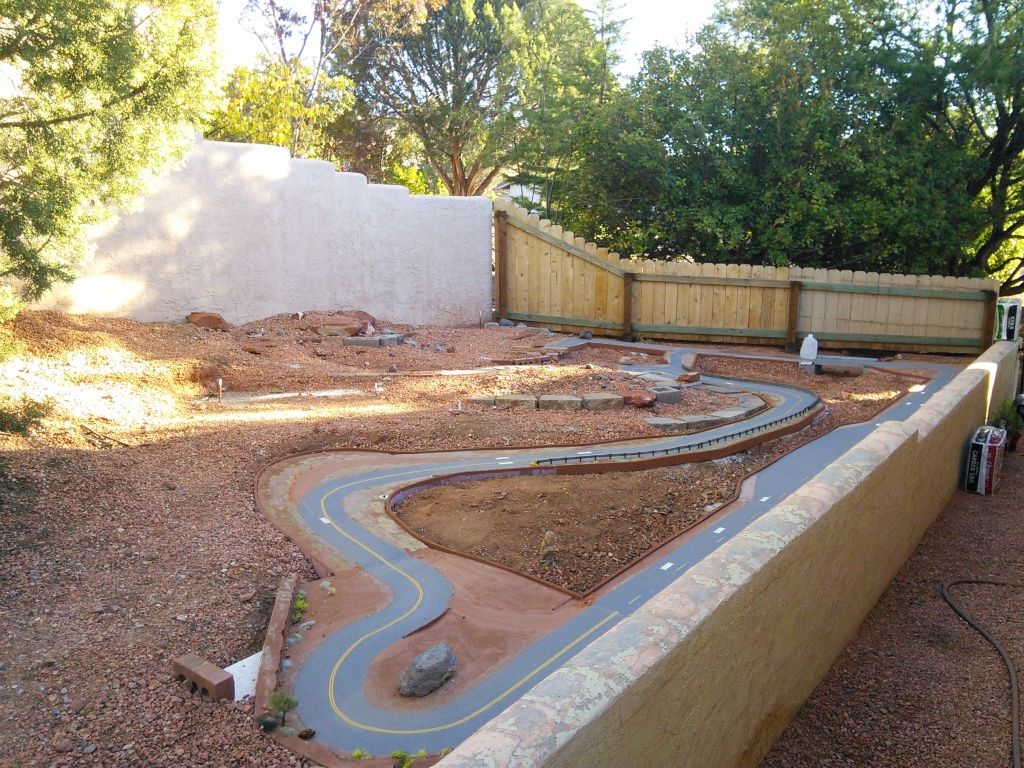
[/URL]
Another picture taken from the southeast corner looking northwest. The long straight by the retaining wall, along with both corners, has been in place for almost 3 months with no signs of damage from the weather yet. But it hasn't been exposed to the intense sun during June or a lot of moisture.
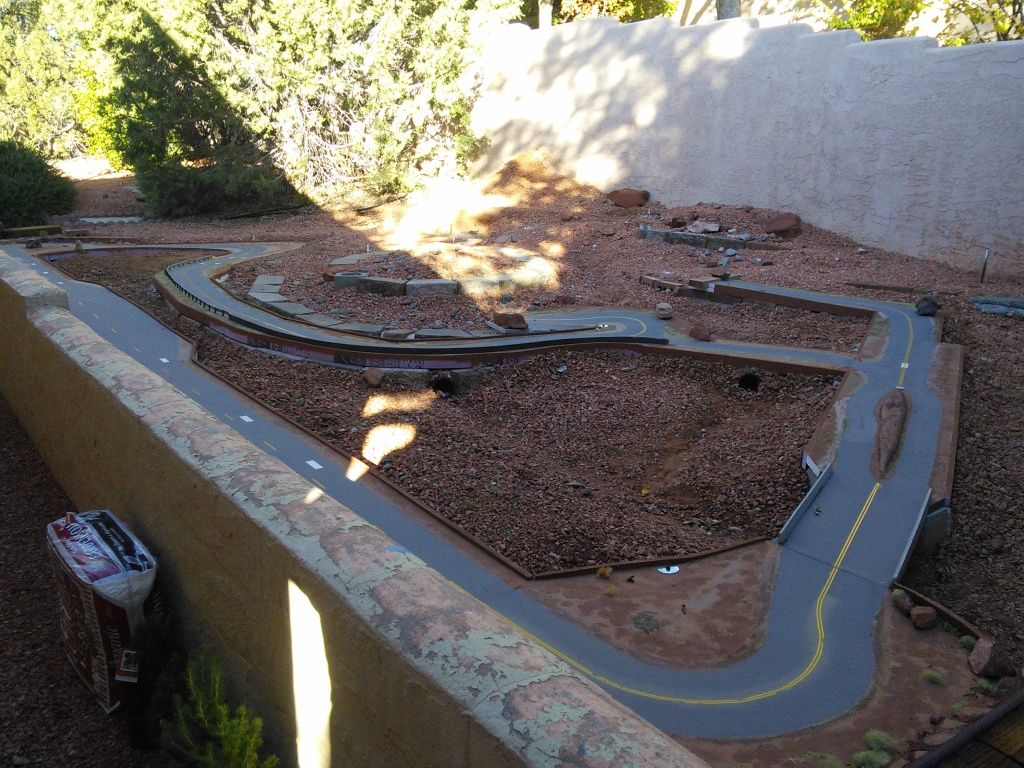
[/URL]
Things are finally starting to take shape but an awful lot remains to be done. Please let me know if you have any more questions or suggestions.
Ned
Re: Materials, Tools, and Techniques for Outdoor Track
Posted: Fri 21. Nov 2014 02:02
by Joel, LeNoir
Quite a impressive layout. Can't wait to see the video of this beast.
Re: Materials, Tools, and Techniques for Outdoor Track
Posted: Fri 21. Nov 2014 02:55
by vmibert
Ned,
I'm feeling much better now - now back to work!
You are truly "paving the way" for outdoor Magracing. You might want to see if you are the very first person to do this!
Now all you need are lights, for night driving!
How have you addressed drainage?
Sincerely,
Bert
Re: Materials, Tools, and Techniques for Outdoor Track
Posted: Fri 21. Nov 2014 08:14
by Lasp
Thanks a LOT!
A very inspiring trackbuilding .
Thats must bee the most closed up to real racing.
You seens too bee on the very right way.
Re: Materials, Tools, and Techniques for Outdoor Track
Posted: Fri 21. Nov 2014 08:19
by Keld
woooaw

This is a fantastic scenery, I really hope you will have success making this, it is really a inspiration for all.


 [/URL]
[/URL] [/URL]
[/URL] [/URL]
[/URL] [/URL]
[/URL] [/URL]
[/URL] [/URL]
[/URL] [/URL]
[/URL] [/URL]
[/URL] [/URL]
[/URL] [/URL]
[/URL] [/URL]
[/URL] [/URL]
[/URL] [/URL]
[/URL]